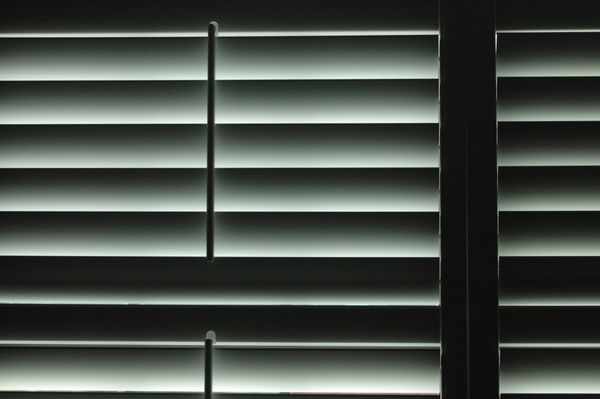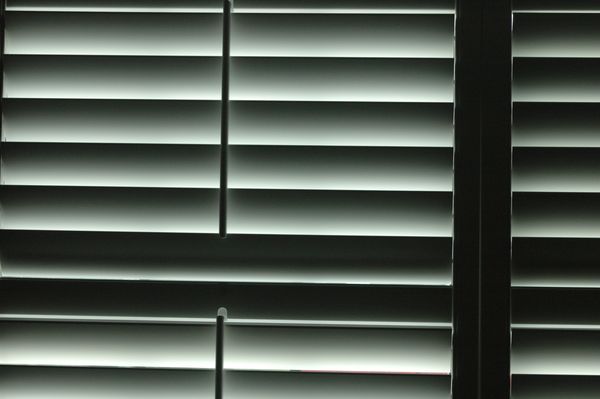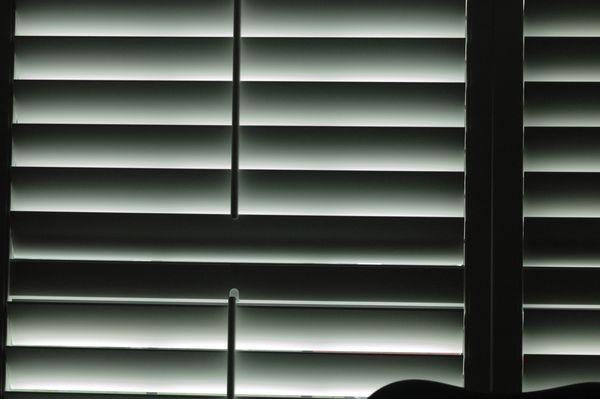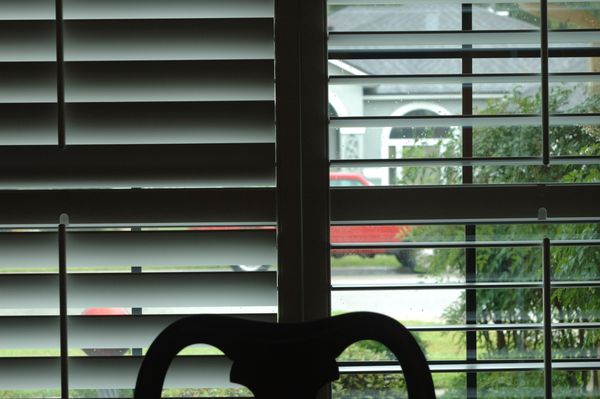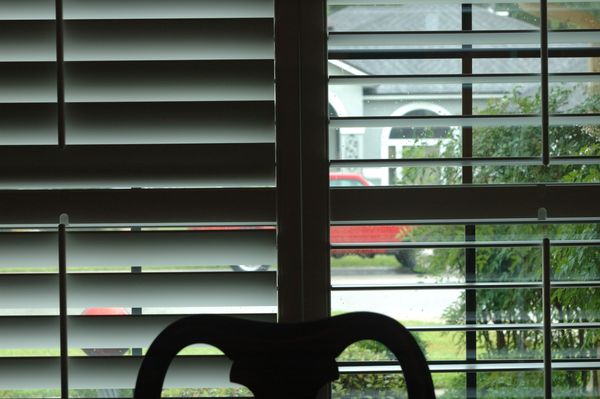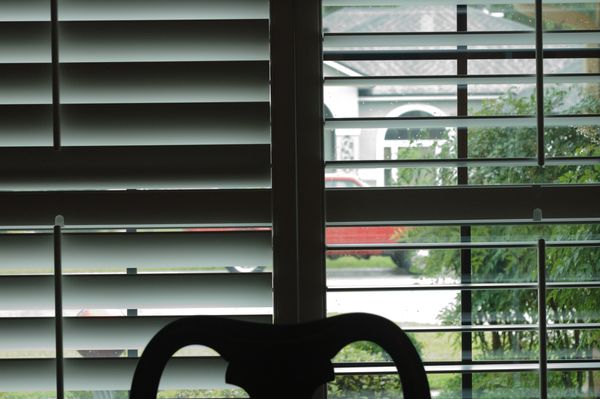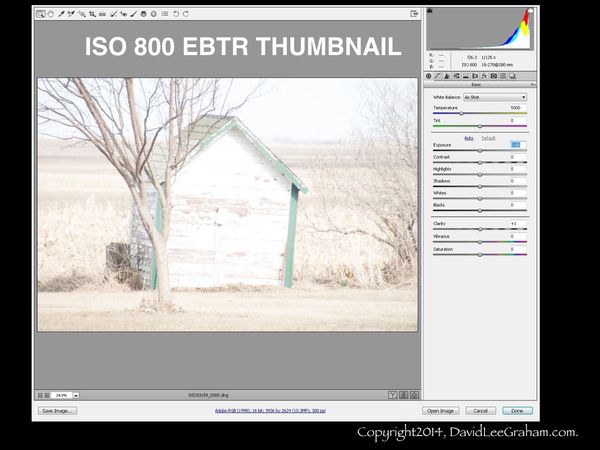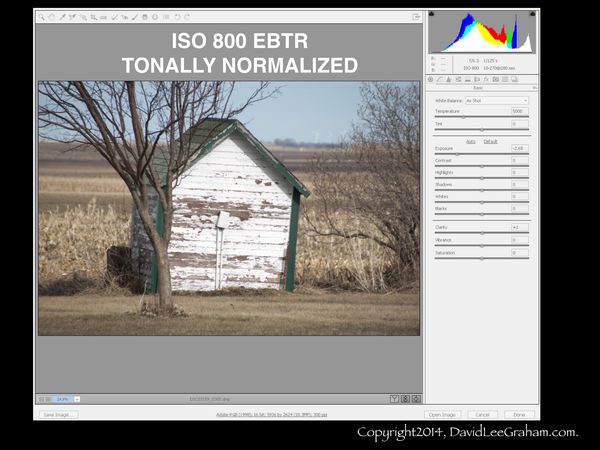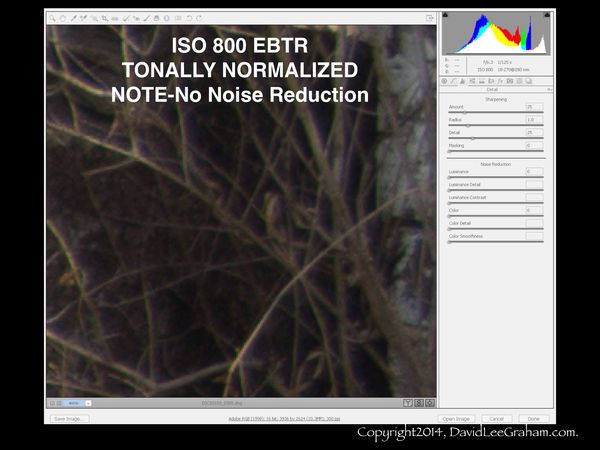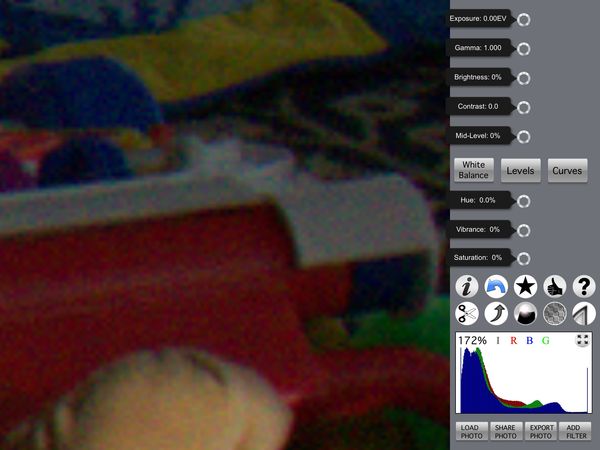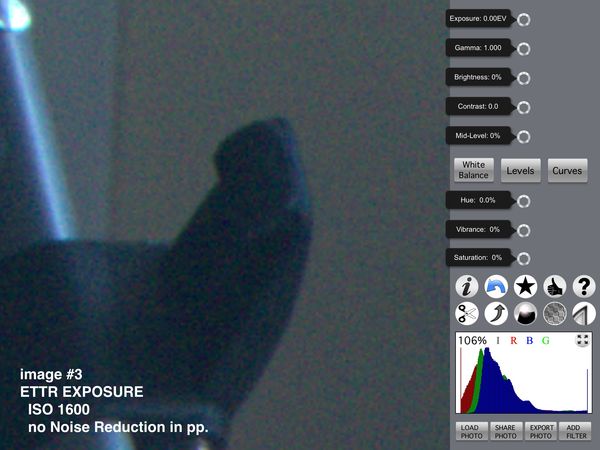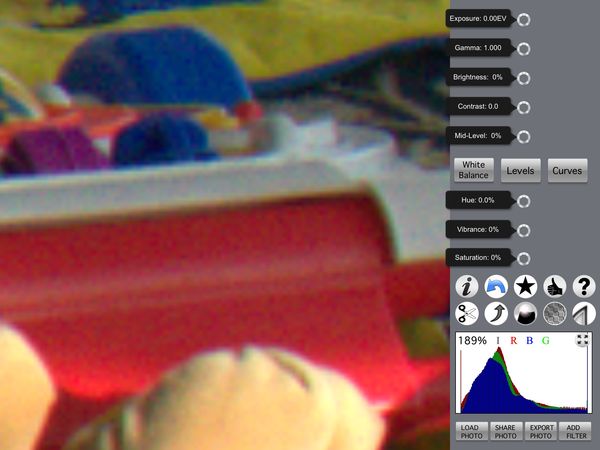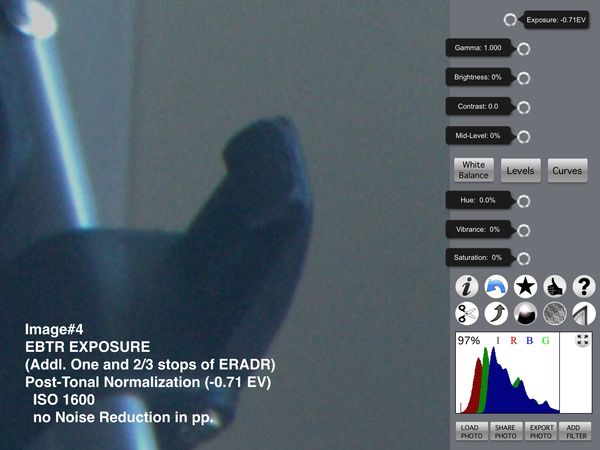ETTR TO THE FAR RIGHT
May 31, 2014 17:19:03 #
Well, Scotty, I'm gratified to see that your horizons have been yet a bit more expanded, this time by having found and aparrently studied the Cambridge disquisition on digital exposure. There are, indeed, some good points therein, but it ought be taken with some well-chosen grains of salt.
I was pleased that the author proclaimed (with consummate wisdom) that : "...the greater the dynamic range, the more important it becomes to use as much of the right-hand side of the histogram as possible.". But then, I was sorely disappointed that the author fails to perceive the significantly different requirements for appropriate initial exposure of a JPEG file on the one hand, and of RAW image data on the other. The common practice of the former function is much that of the photosensitive emusion photograohers since the 1800s. It stands in contradistinction to the needs of appropriately exposing 14-bit-depth RAW image data to permit maximal exercise of its pluripotential ability to permit a great many variations on the theme of the originally captured scene, as well, of course, perfect iteration of the previsualized image. On more occasions than I can now recall you and I have discussed this dichotomy and I see little to be gained by re-hashing your
theoretical polemics and haragues against the demonstrable accomplishments of EBTR, compared with which the fruits of ETTR are but trifling matters.
Scotty, do you, in fact, know how much ERADR each of your digital cameras has?
Scotty said:
"Assume you have your ISO set to 1600 and you capture the scene as the meter recommends - 1/250 and f/11. According to the histogram you are almost but not quite clipping the highlights and shadows. You are pretty sure that you will have noise at the low end but your camera has about 1 stop of extra latitude at the high end for the raw file. So you set your exposure for an additional stop as either 1/125 at f/11 or 1/250 at f/8. In other words, you have overridden the "normal" exposure recommended for ISO 1600 by +1 stop in order to expose to the right."
Your statement "...your camera has about 1 stop of extra latitude at the high end for the raw file..." is supposed to mean what....other than that a full stop of dynamic range has been available but not heretofore used? And you don't have a problem with that? Well, I suppose you wouldn't if you have fewer objections to ETTL than to EBTR. AnD your phrase : "...overridden the "normal" exposure recommended for ISO 1600 by +1 stop in order to expose to the right." simply is evidence your not understanding the process by which the ETTR is determined and the difference between ETTR and EBTR.
So really, Scotty, I have serious doubt that you have ever determined the ERADR of your digital cameras, much less given either ETTR or EBTR a serious try.
I am, however, hopeful that others who may be following this thread may, in fact, have perceived the merits of striving to capture RAW image data of greater quality than attaingable by standard exposure techniques and are giving the practice of EBTR a serious look-see. I'll be delighted to answer any queries on the subject as they come up.
Regards,
Dave
I was pleased that the author proclaimed (with consummate wisdom) that : "...the greater the dynamic range, the more important it becomes to use as much of the right-hand side of the histogram as possible.". But then, I was sorely disappointed that the author fails to perceive the significantly different requirements for appropriate initial exposure of a JPEG file on the one hand, and of RAW image data on the other. The common practice of the former function is much that of the photosensitive emusion photograohers since the 1800s. It stands in contradistinction to the needs of appropriately exposing 14-bit-depth RAW image data to permit maximal exercise of its pluripotential ability to permit a great many variations on the theme of the originally captured scene, as well, of course, perfect iteration of the previsualized image. On more occasions than I can now recall you and I have discussed this dichotomy and I see little to be gained by re-hashing your
theoretical polemics and haragues against the demonstrable accomplishments of EBTR, compared with which the fruits of ETTR are but trifling matters.
Scotty, do you, in fact, know how much ERADR each of your digital cameras has?
Scotty said:
"Assume you have your ISO set to 1600 and you capture the scene as the meter recommends - 1/250 and f/11. According to the histogram you are almost but not quite clipping the highlights and shadows. You are pretty sure that you will have noise at the low end but your camera has about 1 stop of extra latitude at the high end for the raw file. So you set your exposure for an additional stop as either 1/125 at f/11 or 1/250 at f/8. In other words, you have overridden the "normal" exposure recommended for ISO 1600 by +1 stop in order to expose to the right."
Your statement "...your camera has about 1 stop of extra latitude at the high end for the raw file..." is supposed to mean what....other than that a full stop of dynamic range has been available but not heretofore used? And you don't have a problem with that? Well, I suppose you wouldn't if you have fewer objections to ETTL than to EBTR. AnD your phrase : "...overridden the "normal" exposure recommended for ISO 1600 by +1 stop in order to expose to the right." simply is evidence your not understanding the process by which the ETTR is determined and the difference between ETTR and EBTR.
So really, Scotty, I have serious doubt that you have ever determined the ERADR of your digital cameras, much less given either ETTR or EBTR a serious try.
I am, however, hopeful that others who may be following this thread may, in fact, have perceived the merits of striving to capture RAW image data of greater quality than attaingable by standard exposure techniques and are giving the practice of EBTR a serious look-see. I'll be delighted to answer any queries on the subject as they come up.
Regards,
Dave
May 31, 2014 20:42:31 #
Uuglypher wrote:
I see little to be gained by re-hashing your theoretical polemics and haragues
Whose?
Uuglypher wrote:
Scotty, do you, in fact, know how much ERADR each of your digital cameras has?
If I bought into your argument I would take the trouble to find out.
----------------------------------------------------------------
Rather than pursue a theoretical approach that probably has lost us all of our followers, I performed a simple experiment this morning with my old D70, a camera that easily produces noisy images and so Nikon deliberately limited its top ISO to 1600.
I used the matrix/average metering method on a scene on with the ISO set to 800 and for a normal exposure of 1/30 at f/11. The camera was set to Manual. Without changing the aperture or shutter speed, I took three images: at ISO 800, 400 and 1600. I then adjusted the exposure in capture NX2 by increasing the exposure for image 2 and reducing it for image 3 each by one stop. NX2 did not keep the ISO in the EXIF information so you will have to take my word for it. But this is such a simple experiment anyone can replicate it.
The noise in all three images was identical, as I expected, since all three received the exact same amount of light. The histograms for the initial raw images were shifted left (image 2) and right (image 3) but exposure compensation made them look pretty much the same. The only difference was that the shadows in image 2 and highlights in image 3 may have been slightly clipped and not entirely recovered since the D70 may not actually have a whole stop of additional range in the raw file.
With a better camera you can repeat thus process with more than a 1-stop shift in each direction and definitely clip the shadows and highlights. Either way it clearly demonstrates that it is the absolute exposure, not the ISO, that is the source of noise.
Jun 1, 2014 09:36:53 #
selmslie wrote:
... I performed a simple experiment this morning with my old D70 ...
I ran the same test today with wider spacing. This time the weather was overcast so I opened a couple of the shutters to get some more variation in brightness. I also turned off the Long exp NR option to keep the image as simple as possible although I suspect that it would not have played a part.
The exposure for all three images was 1/10 sec at f/8 based on a matrix/average reading at ISO 500.
All three images received exactly the same amount of light and thereby the same signal, same base noise and same S/N ratio. The first image was exposed normally for ISO 500. The other two images were at ISO 200 and 1250. I adjusted the the darker image by adding 1.33 steps of compensation in the raw converter and I subtracted 1.33 from the lighter version. The resulting images were the same in the middle tones. I could see no difference in the noise among any of the images.
There was some clipping of the highlights in image 3 clearly visible in the reflecting ball in the lower left and harder to see in the grass and the roof across the street. Even with a 12-bit raw file, I saw no banding or posterization in the darker areas.
As for blinkies, I got them in the ISO 500 and 1250 versions but not with ISO 200, so the D70 knew I was on thin ice.
It is safe to conclude that there is less than 1-1/3 stops of additional latitude available in the 12-bit raw file. How much less? I don't really care - it's not my go-to camera.
Jun 1, 2014 12:32:03 #
"The noise in all three images was identical, as I expected, since all three received the exact same amount of light."
"Either way it clearly demonstrates that it is the absolute exposure, not the ISO, that is the source of noise."[/quote]
And in the next post your "bottom line is "All three images received exactly the same amount of light and thereby the same signal, same base noise and same S/N ratio."
All three statement are a priori evidence that you have not in any manner, illustrated any putative fallacy in the theory and practice of EBTR !
and finally you admit:
[quote=selmslie]If I bought into your argument I would take the trouble to find out......
...which means that your previous claim to have experimented with ETTR and with EBTR (the latter of which requires you do what you now admit to not having done... )and found them complicated and difficult to usek was simply not the case! You have, clearly, grossly misunderstood the basic premises upon which EBTR is predicated.
Scotty, I cannot imagine that, had you purchased a camera with a given dynamic range, you would theorize some reason NOT to utilize the last stop...or two...or more (if available) of that DR. In denying the logic of EBTR and the benefits thereof you are doing precisely the same thing! Your theorizing and postulating are woefully off base, Scotty, and thus meaningless in attempting to bloster, your so-far, irrational antipathy to EBTR.
Dave
"Either way it clearly demonstrates that it is the absolute exposure, not the ISO, that is the source of noise."[/quote]
And in the next post your "bottom line is "All three images received exactly the same amount of light and thereby the same signal, same base noise and same S/N ratio."
All three statement are a priori evidence that you have not in any manner, illustrated any putative fallacy in the theory and practice of EBTR !
and finally you admit:
[quote=selmslie]If I bought into your argument I would take the trouble to find out......
...which means that your previous claim to have experimented with ETTR and with EBTR (the latter of which requires you do what you now admit to not having done... )and found them complicated and difficult to usek was simply not the case! You have, clearly, grossly misunderstood the basic premises upon which EBTR is predicated.
Scotty, I cannot imagine that, had you purchased a camera with a given dynamic range, you would theorize some reason NOT to utilize the last stop...or two...or more (if available) of that DR. In denying the logic of EBTR and the benefits thereof you are doing precisely the same thing! Your theorizing and postulating are woefully off base, Scotty, and thus meaningless in attempting to bloster, your so-far, irrational antipathy to EBTR.
Dave
Jun 1, 2014 14:27:58 #
Uuglypher wrote:
... Your theorizing and postulating are woefully off base, Scotty, and thus meaningless in attempting to bloster, your so-far, irrational antipathy to EBTR. ...
In the final analysis, either ETTR, EBTR or a less complicated form of metering that leads to the same level or lack of noise will likely end up at about the same exposure. What I demonstrated above is that it's not the ISO that keeps the noise down, it's the total amount of light reaching the sensor.
The examples I provided also show that, even with a 12-bit raw file, you have plenty of value steps to avoid banding or posterization in the darker areas if you do your initial processing in the raw image. If your raw processor does not provide enough flexibility (like gradients and vignetting) you can save to a 16-bit TIFF and continue to avoid posterization or banding.
I am reluctant to adapt ETTR methods simply because, even with an inferior D70, I have not seen a need for it it. My D7000 and D610 have superior noise performance and provide a 14-bit raw file. There is no incentive for me to complicate my exposure setting when I can get to the same exposure more directly. Of course I watch the histogram, if only because I cannot trust my LCD screen in broad daylight.
What has been left out of this discussion is whether the photographer might actually want to clip the high values to get areas of pure white or the shadows to get areas of pure black. This is often a useful compositional feature where ETTR will not help.
The other thing that we have not stressed is that it is more important to avoid blowing the highlights than blocking the shadows. ETTR is playing with fire so you will probably end up having to bracket anyhow just to be safe. This is particularly true if you invested a whole lot of money and effort to get to some exotic location for the only time in your life.
Maybe you can provide a demonstration as simple as mine to convince us otherwise. More verbiage is not going to do it.
Jun 1, 2014 16:40:22 #
selmslie wrote:
In the final analysis, either ETTR, EBTR or a less... (show quote)
xxxxxxxxxxxxx
Scotty,
Here's an example of the result of EBTR made recently with a Sony Alpha99
using 1 and 1/3 stop of ERADR.
The basic exposure was adjusted with shutter speed to reach ETTR, to which one and 1/3 stops (ERADR) was added. ISO 800.
The first image is a screen grab of the un-normalized image file opened in A.C.R..
The second is the same file subjected to tonal normalization only by left-sliding the Exposure slider.
The third image is a 400X view of the shadow detail ( left rear corner of shed) where no Noise Reduction has been performed ( note that the defalt NR settings have been reduced to zero. Check it out for noise.
Note that in order to accomplish this result it requires no great mastery of a complicated principle and years of practice, It's straight forward and the most critical point is having enough practice with accurately determining the ETTR exposure so that adding the pre-determined ERADR is a piece of cake. Your great fear of ETTR is totally mystifying to me. Please explain where you run into trouble with it.
Dave
Jun 1, 2014 18:00:15 #
Uuglypher wrote:
... Here's an example of the result of EBTR made recently with a Sony Alpha99
using 1 and 1/3 stop of ERADR.
The basic exposure was adjusted with shutter speed to reach ETTR, to which one and 1/3 stops (ERADR) was added. ISO 800. ...
using 1 and 1/3 stop of ERADR.
The basic exposure was adjusted with shutter speed to reach ETTR, to which one and 1/3 stops (ERADR) was added. ISO 800. ...
You need to do better than that. Here is why.
You have described your procedure, which I understand very well, but you have not given us an illustration of how it improved your image. All you show is that you did not blow the highlights.
We have already established that you could have achieved the same noise level if you had simply metered the scene normally with an ISO of 320 instead of 800. It would have given you the same shutter speed directly without having to drop it by 1-1/3 stop from the basic exposure you got for ISO 800. Since I would have used an ISO of 100 for an outdoor scene in daylight, you still have more potential for noise than I do with my D610. Regardless, neither the D610 nor the Alpha99 would be likely to have a noise issue below an ISO of 400 when metered conventionally. So you do not demonstrate any benefit in noise reduction.
You do not show any improvement in shadow tonality, texture or detail since you have not provided an example of the same scene exposed without EBTR. So you do not illustrate any benefit from the improvement in tonality or reduction in banding or posterization.
In order to convince me (us) you will need to provide an image that could not have been as good as one where you simply used a low ISO with conventional metering. Of course this means two images, an exposure metered conventionally and an EBTR version.
Please give this some thought and try again.
Jun 1, 2014 20:38:23 #
selmslie wrote:
You need to do better than that. Here is why. br ... (show quote)
Xxxxxx
Honestly Scotty,
I labor under absolutely no illusions that, if these images are not instructive to you, that any others will be.
1. Note the washed out (to you and other nay-Sayers incontrovertible evidence of "overexposure" in your terms based on the JPEG-adjusted thumbnail)
2.Note complete tonal reconstitution with NO CLIPPED HIGHLIGHTS.
3. Note the absence ...ABSENCE ...OF NOISE even though "overexposed" in your terms and shot at ISO 800 ( while yours were shot at ISO 500 in a manner that bore no relationship to any technique that would rationally argue against EBTR) and
4. Note the total absence of ANY post-processing Noise Reduction (even the Default Noise Reduction actions were reduced to Zero !)
You'll never accept the validity and utility of EBTR not because it doesn't deliver as promised ( because it DOES) but because you believe that reciting meaningless pseudo-objective theories that would make Hurter and Driffield and Ansel Adams spin in their graves will somehow convince other photographers to believe your drivel rather than their own eyes.
The evidence here is clear and irrefutable. To deny it discredits naught but your continued efforts to deny it.
If and when I find the time to provide you with other convincing images, I'll post some to you, but it has been, literally, years since the need for comparative images such as the ones you now request were necessary, either as back-up or as comparative "proof" of the utility and efficacy of EBTR.
Muddle on, as is your wont, with your version of "appropriate" or "correct" exposure and with your attempts to befuddle those who might (sadly) be impressed by your nonsensical pseudo-scientific theorizing salted with inane references to the Zone System of Exposure.
Your accepted role of nay-sayer re: EBTR will become, as time goes on, and as the principle of EBTR becomes more and more widely adopted by competent photographers World-wide, a futile, time-consuming and progressively less-and-less rewarding one.
Not a month goes by that I do not receive a steadily increasing number of requests for advice on EBTR and evaluation of "ERADR determination image sets", the demand for which is a clear index of the growing interest in serious pursuit of a superior concept by which improved quality of RAW image data can be assured.
It is unfortunate that you, on the other hand, should consciously choose to remain an anachronistic stumbling block to real and practical advancement of digital photography. I wish you well in all other undertakings, Scotty, but in this effort to discredit the concept of EBTR, you have doomed yourself to ultimate discredit and severely diminished repute.
My participation in this discussion is concluded and I leave reading of any further inane disputation with the concept of EBTR from you to the few whom you have somehow convinced of the validity of your supposedly knowledgeable, but clearly disproven opinions.
Dave
Jun 1, 2014 21:32:05 #
Uuglypher wrote:
... My participation in this discussion is concluded and I leave reading of any further inane disputation with the concept of EBTR from you to the few whom you have somehow convinced of the validity of your supposedly knowledgeable, but clearly disproven opinions. ...
Unfortunately this is your problem. You have presented us with a clear understanding of the cost (effort) of ETTR/EBTR without presenting any evidence of the benefit (improved images). In other words, you have not demonstrated or proved what are we missing by not using ETTR or EBTR - or what we have to gain from it. This is not just your problem - you have not even referred us to anyone who has demonstrated it either.
As Judge Judy would say, "If you can't show it to me it does not exist."
You have presented your assertions ad nauseam wanting us to accept them on faith. You feel we should just take your word for it. You might get away with this as a teacher but in the business, engineering or scientific world your ideas simply would not sell.
Incidentally, this might be a fun read: http://theonlinephotographer.typepad.com/the_online_photographer/2011/10/expose-to-the-right-is-a-bunch-of-bull.html It was written in 2011 by Ctein who has a been in the business for a long time and really knows what he is talking about and how to present his point.
Ctein wrote:
Once upon a time, this rule made a certain amount of sense, although not as much as its proponents ever claimed. Once upon a time, digital cameras were pretty noisy beasts, and suppressing that image noise was one of the more important ways to improve image quality. ... These days, noise is really not a big source of image quality loss, unless you're that particular kind of photo-fetishist ...
Editor's Note wrote:
... The Luminous-Landscape about ETTR. That article was published in 2003, when, as Ctein acknowledges, ETTR made more practical sense. From 2003 to 2011 has been a very long time in this particular stretch of the history of photographic technology. ...
I had not read this article before but a lot of what it states will be familiar to you from my earlier comments.
Jun 2, 2014 07:41:16 #
Dave, it looks like you are throwing in the towel.
Although there is some merit to the method, I'm afraid ETTR is an approach whose time has passed - a solution to a problem that no longer exists since it no longer provides any demonstrable benefits. Careful metering and attention to the histogram, particularly the highlights, should be enough.
You might not be as amused as the rest of us by another posting by Ctein: http://theonlinephotographer.typepad.com/the_online_photographer/2007/11/the-photo-fetis....
I don't imply that you "pursue it [ETTR] to the exclusion of all others" but your fervor seems excessive.
Scotty
Although there is some merit to the method, I'm afraid ETTR is an approach whose time has passed - a solution to a problem that no longer exists since it no longer provides any demonstrable benefits. Careful metering and attention to the histogram, particularly the highlights, should be enough.
You might not be as amused as the rest of us by another posting by Ctein: http://theonlinephotographer.typepad.com/the_online_photographer/2007/11/the-photo-fetis....
Ctein wrote:
Photography has always had its fetishists, who not only embrace one small aspect of photographic quality and pursue it to the exclusion of all others, but are fervent in their belief that we should all follow in their feverish footsteps.
I don't imply that you "pursue it [ETTR] to the exclusion of all others" but your fervor seems excessive.
Scotty
Jun 3, 2014 15:21:25 #
selmslie/Scotty,
Throwing in the towel? Not at all, Scotty, simply tired of your your non-sensical pseudo-technical justifications for your antipathy to the obvious benefits of EBTR, as well as your ...(not to put too fine a point on it...) inconsistency ...in argumentation.
You earlier stated that you had tried the technique and found it unsatisfactory and too complicated to use...and then later admitted to never having determined the ERADR of your camera...a sine qua non of the subsequent practice of EBTR.
You've either been too embarrassed to admit your ignorance of the process and would rather prevaricate to cover that ignorance, or are simply too lazy to do the minimal groundwork necessary to practice EBTR. I had hoped that you could ultimately be shamed into knuckling down and doing it right rather than continue with your ludicrous tactic of spouting non-sensical pseudo-technical pronouncements as to why EBTR wouldn't work. Unfortunately, the best you've been able to muster is to admit, with increasing frequency, is that EBTR may, in fact, "...have some merit".
You purport to support your arguments with images that in no way illustrate any rational argument against EBTR, and then pretend, again with double-talk, that the incontrovertible evidence my images have shown do not illustrate absolute proof of the advantage of EBTR in reduction of image noise, regardless of the ISO used.
EBTR is not hard to understand or to practice. You need but understand that the further to the right you can collect your RAW image data from the "dark side ( noise-laden) region of the JPEG-adjusted histogram frame, the less noise will be found in the shadow regions of your ultimate image.
You have gradually had to admit the principle, yet continue to deny its utility in practice. You've become so vested in your position against EBTR that you simply find it impossible to admit that you are wrong,
And now you quote a fellow (Ctein) known for his stand and who, as do you and others of your ilk , spouts theory rather than shows evidence from practice, and who who claims the need for ETTR/EBTR no longer exists? It was he and you and others like-minded that Jeff Schewe targeted with "De-debunking ETTR" <schewephoto.co,/ETTR> As long as luminous and/or color noise is a perceptible cause of image degradation there is and will continue to be a need to practice EBTR. It's hardly a technique whose " time has passed" ...as my images below clearly show.
The attached images, illustrating that, even when using a high ISO both luminous and color noise is reduced by using EBTR. I had hoped you would have the integrity to try it yourself, but since you haven't, here are some examples of noise present in ETTR exposures and significantly reduced in the EBTR exposures of the same scenes. The ISO WAS 1600. Indeed, when lesser ISOs are used, and depending on your camera's sensor, with EBTR you can produce images requiring little or NO noise reduction in post-processing as was illustrated in an earlier post.
So, have I "thrown in the towel"? Not at all; I've just decided that it's unkind to continue to batter a sorely unequipped, ignorant opponent who seemingly will never admit the hopelessness of his failed cause to which he pitifully clings with unreasoned fervor.
I do wish that it had been you, instead of I who had made these images.
Argue and decry them as you will...and I am, of course, sure that you will... they do, regardless of your predictable protestations, unequivocally illustrate that the further to the right you can collect your shadow data, the more photons reach each photo site, and the less noise that data will, as a consequence, contain after tonal normalization....regardless of the ISO used.
That's the essence of EBTR.
'Taint hard, Scotty, not even complicated...in fact it's really simple ...and most important of all, EBTR is, today, as effective as it was ten years ago, Ctein's and your hopeless theorizing notwithstanding.
Are you a poker player? If so, I leave you with:
"Read'em and weep!"
(And be sure to view the downloads so you can't claim not to perceive the marked reduction in image noise!)
Dave in SD
Throwing in the towel? Not at all, Scotty, simply tired of your your non-sensical pseudo-technical justifications for your antipathy to the obvious benefits of EBTR, as well as your ...(not to put too fine a point on it...) inconsistency ...in argumentation.
You earlier stated that you had tried the technique and found it unsatisfactory and too complicated to use...and then later admitted to never having determined the ERADR of your camera...a sine qua non of the subsequent practice of EBTR.
You've either been too embarrassed to admit your ignorance of the process and would rather prevaricate to cover that ignorance, or are simply too lazy to do the minimal groundwork necessary to practice EBTR. I had hoped that you could ultimately be shamed into knuckling down and doing it right rather than continue with your ludicrous tactic of spouting non-sensical pseudo-technical pronouncements as to why EBTR wouldn't work. Unfortunately, the best you've been able to muster is to admit, with increasing frequency, is that EBTR may, in fact, "...have some merit".
You purport to support your arguments with images that in no way illustrate any rational argument against EBTR, and then pretend, again with double-talk, that the incontrovertible evidence my images have shown do not illustrate absolute proof of the advantage of EBTR in reduction of image noise, regardless of the ISO used.
EBTR is not hard to understand or to practice. You need but understand that the further to the right you can collect your RAW image data from the "dark side ( noise-laden) region of the JPEG-adjusted histogram frame, the less noise will be found in the shadow regions of your ultimate image.
You have gradually had to admit the principle, yet continue to deny its utility in practice. You've become so vested in your position against EBTR that you simply find it impossible to admit that you are wrong,
And now you quote a fellow (Ctein) known for his stand and who, as do you and others of your ilk , spouts theory rather than shows evidence from practice, and who who claims the need for ETTR/EBTR no longer exists? It was he and you and others like-minded that Jeff Schewe targeted with "De-debunking ETTR" <schewephoto.co,/ETTR> As long as luminous and/or color noise is a perceptible cause of image degradation there is and will continue to be a need to practice EBTR. It's hardly a technique whose " time has passed" ...as my images below clearly show.
The attached images, illustrating that, even when using a high ISO both luminous and color noise is reduced by using EBTR. I had hoped you would have the integrity to try it yourself, but since you haven't, here are some examples of noise present in ETTR exposures and significantly reduced in the EBTR exposures of the same scenes. The ISO WAS 1600. Indeed, when lesser ISOs are used, and depending on your camera's sensor, with EBTR you can produce images requiring little or NO noise reduction in post-processing as was illustrated in an earlier post.
So, have I "thrown in the towel"? Not at all; I've just decided that it's unkind to continue to batter a sorely unequipped, ignorant opponent who seemingly will never admit the hopelessness of his failed cause to which he pitifully clings with unreasoned fervor.
I do wish that it had been you, instead of I who had made these images.
Argue and decry them as you will...and I am, of course, sure that you will... they do, regardless of your predictable protestations, unequivocally illustrate that the further to the right you can collect your shadow data, the more photons reach each photo site, and the less noise that data will, as a consequence, contain after tonal normalization....regardless of the ISO used.
That's the essence of EBTR.
'Taint hard, Scotty, not even complicated...in fact it's really simple ...and most important of all, EBTR is, today, as effective as it was ten years ago, Ctein's and your hopeless theorizing notwithstanding.
Are you a poker player? If so, I leave you with:
"Read'em and weep!"
(And be sure to view the downloads so you can't claim not to perceive the marked reduction in image noise!)
Dave in SD
Jun 3, 2014 17:18:52 #
Uuglypher wrote:
... Throwing in the towel? Not at all ..
Dave,
To start with, you need to tone down your language and stop resorting to insults. It is not dignified and does not advance your argument. It just serves to illustrate your frustration.
Your examples only reinforce what I have already demonstrated, that lack of signal relative to base noise is the source of visible noise.
In the two demonstrations I posted earlier, all three images for each set received the same exposure. In each case, the first image was exposed normally, the second was exposed at a lower ISO (ETTL) and the third at a higher ISO (ETTR). Because all three images in each set were shot at the same aperture and shutter speed, all three images displayed the same visible noise. ETTR had noting to do with reducing noise and ETTL did not make it worse.
In your samples, the second pair of images received more exposure than the first two but you did not reveal how or where these shots were taken. Daylight outdoor, in the shade or indoor? By exposing as ISO 1600 and then adding 1-2/3 step more exposure you nearly doubled the signal, presumably by using a longer exposure. The second set ended up with the same exposure as if it had been metered normally at ISO 500.
The best ways to increase the S/N ratio is to use a camera with less inherent noise, shoot in brighter light, shoot with a larger aperture and/or longer (but not too long) shutter speed or shoot at a lower temperature.
So you still have not demonstrated any benefit for ETTR that I could not duplicate by simply lowering my ISO. You might as well give up on that part of your argument and concentrate on the other aspect.
Does ETTR improve tonality and detail in the shadows? In theory it should, but we can't see theories. Can you demonstrate it?
This time, please stick to the facts, be brief and show us an example we can reproduce.
Scotty
Jun 3, 2014 18:28:33 #
Uuglypher wrote:
The attached images, illustrating that, even when using a high ISO both luminous and color noise is reduced by using EBTR.
In the meantime, can you supply us with the actual exposure settings you used for the attached images? Your demonstration is incomplete without them.
Jun 3, 2014 19:37:37 #
You seem not yet to have caught on to the fact that a metered exposure is, unlike in JPEG file exposure, immaterial in exposing RAW data by EBTR. The point is simply to expose with the maximum exposure that will not clip the highlights. The easiest and most accurateway to do that is to start with an ETTR exposure, and add your pre-determined ERADR. Your unreasoning fear of clipping highlights is truly unfounded once facility in achieving ETTR is gained. You seem to acknowledge that more exposure is instrumental in improving S:N.. Take that to the max possible and you attain the maximum benefit of EBTR, which my last images illustrate. I'm presently on the road and thus have no access to other than an iPad-adapted raw converter ("piRAWnha"), but the fact of significant Noise reduction via EBTR is clear to see. An outdated technique? Obviously not.
There is no question that a lower ISO results in less noise (higher S:N) than does a higher ISO. Nor do you seem to argue that more exposure ( exposing farther and farther from the " dark side" of the JPEG-adjusted histogram....AND BEYOND... results in less noise even in the darker portions of the image. Again , Scotty, those are the basics upon which EBTR is founded. Whence your antipathy to working those two facts into your exposure technique?
Did I misinterpret the inconsistencies in your excuses for not having actually practiced EBTR? Terribly sorry if I did...but...somehow the claim that you had done so, and then, later, obvious evidence in your own words that you couldn't have done so led me to an unfortunate, yet inescapable conclusion. If I did misunderstand those explicit statements, perhaps you can clear that up?
You have been shown examples you can reproduce, if you but decide to knuckle down, determine your camera's ERADR, set the ETTR exposure, and add the determined ERADR. Simple as that, Scotty.
You continue to tell one who has productively used the process of EBTR for the better part of a decade that it can't work. I feel no need to further recapitulate all the work that went into my self-education in the process and that have allowed its routine, indeed, quotidian employment. And I really could not care less if you ever learn its benefits, particularly since you've personally made no effort to actually put it into practice.
Give it a go, lad,and, if you are of a mind to, let me know when you've done precisely that. (Until you've tried it, your objections are but dust in the wind.)
No, I'm not holding my breath, but would love to hear that you've actually tried it.
Dave
There is no question that a lower ISO results in less noise (higher S:N) than does a higher ISO. Nor do you seem to argue that more exposure ( exposing farther and farther from the " dark side" of the JPEG-adjusted histogram....AND BEYOND... results in less noise even in the darker portions of the image. Again , Scotty, those are the basics upon which EBTR is founded. Whence your antipathy to working those two facts into your exposure technique?
Did I misinterpret the inconsistencies in your excuses for not having actually practiced EBTR? Terribly sorry if I did...but...somehow the claim that you had done so, and then, later, obvious evidence in your own words that you couldn't have done so led me to an unfortunate, yet inescapable conclusion. If I did misunderstand those explicit statements, perhaps you can clear that up?
You have been shown examples you can reproduce, if you but decide to knuckle down, determine your camera's ERADR, set the ETTR exposure, and add the determined ERADR. Simple as that, Scotty.
You continue to tell one who has productively used the process of EBTR for the better part of a decade that it can't work. I feel no need to further recapitulate all the work that went into my self-education in the process and that have allowed its routine, indeed, quotidian employment. And I really could not care less if you ever learn its benefits, particularly since you've personally made no effort to actually put it into practice.
Give it a go, lad,and, if you are of a mind to, let me know when you've done precisely that. (Until you've tried it, your objections are but dust in the wind.)
No, I'm not holding my breath, but would love to hear that you've actually tried it.
Dave
Jun 3, 2014 20:37:44 #
Uuglypher wrote:
You seem not yet to have caught on
The point is simply to expose with the maximum exposure that will not clip the highlights.
I am well aware of how to execute an exposure by applying ETTR or EBTR without blowing the highlights. What I am waiting to see from you is an explanation of why I should do it. I know the cost. Now show us the benefit. Don't expect us to take your word for it, on faith.
There are plenty of well-reasoned articles available that describe the technique, including http://www.dpreview.com/articles/6641165460/ettr-exposed Early in this article is the statement It is important to understand that ETTR s always enacted at base ISO. Yet, in all of your examples, you have been starting at ISO 1600. This seems like you are artificially introducing noise into the image so ETTR can take credit for removing it. This is not only bad science, it is disingenuous - flimflam.
I have already proved that the volume of light reaching the sensor relative to the sensors base noise (S/N) is what determines whether the image will display noise. ETTR has nothing to do with this and ISO only affects the way the camera interprets that signal and encodes it into the raw file.
Uuglypher wrote:
There is no question that a lower ISO results in less noise (higher S:N) than does a higher ISO.
Absolutely incorrect, as I have already shown with two simple examples that anyone can reproduce for themselves. Lowering the ISO simply leads you to use a more generous exposure.
Uuglypher wrote:
You have been shown examples you can reproduce
Actually, you have not shown us an example we could reproduce since you did not reveal the details of how you metered and captured your exposures other than to imply that, with nearly three times as much illumination (almost two stops), the noise was less visible - duh.
Uuglypher wrote:
No, I'm not holding my breath, but would love to hear that you've actually tried it.
I have told you that I understood it completely and have tried it but it did not make any visible difference with a better camera like my D7000 or D610. I am still waiting for you to come up with a simple demonstration using a decent camera. Tell us the actual ISO, aperture and shutter speed settings for the non-ETTR and ETTR version, so you can show us the difference - the benefit.
If you want to reply, then register here. Registration is free and your account is created instantly, so you can post right away.


